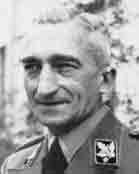Arthur Nebe
(1894 - 1945)

Arthur Nebe was born on November 13, 1894, in Berlin. He volunteered for military service fighting in the 17th Pioneer Battalion during World War I, where he was wounded twice by poison-gas.
In 1920, Nebe was accepted into the criminal police and, in 1923, he became a criminal police commander. Nebe joined the SS, the Nazi Party, and the SA in 1931. When Hermann Goering became minister of the interior in Prussia in 1933, he recruited Nebe to work with Rudolf Diels in the Gestapo.
Though initially a supporter of Hitler and his vows to restore Germany to great power status, Nebe developed doubts about the Nazi regime following the Night of the Long Knives in 1934. As his misgivings grew, he confided to his close friend and colleague, Hans Gisevius, his intention to resign from the force, especially after the Criminal Police was absorbed into the SS. Gisevius persuaded him to stay on arguing that the conspirators opposed to Hitler needed someone inside Heinrich Himmler’s empire to document the crimes that were being perpetrated by the Nazi regime – evidence they hoped to use to bring Hitler, Goering, Himmler, and the rest to justice.
In June 1937, Nebe became director of the Reich criminal police (KRIPO) for all of Germany. In 1938, Nebe joined forces with future co-conspirator Dr. Carl Sack (Judge Advocate-General of the German Army) to sabotage Himmler’s plot against General Werner von Fritsch.
General Hans Oster recruited Nebe into the conspiracy for the September 1938 coup attempt. Nebe supplied his colleagues with vital information regarding SS strength, logistics, and safehouses throughout the Berlin area.
In mid-1941, Nebe volunteered to head an Einsatzgruppe – one of the mobile killing units responsible for the extermination of more than one million Jews in the Soviet Union. Nebe commanded Einsatzgruppe B until October 1941. He played a significant role in making killing methods more efficient and, under his command, the unit killed over 45,000 people. Some accounts say that he saved thousands of Russian civilians from execution by falsifying figures. His fellow SS-Einsatzgruppen colleagues supposedly accused him of being “too soft.”
Himmler visited Minsk during August 1941 and instructed Nebe to carry out in his presence an execution of one hundred inmates of a prison in Minsk. Karl Wolff, who was then Himmler’s Liaison Officer at Hitler’s headquarters, recalled that Himmler was shaken by the gruesome experience and instructed Nebe to find a better method for mass murder.
Nebe and Dr. Albert Widmann, a German chemist who worked for the T4 euthanasia program, carried out a number of experiments to kill patients from various lunatic asylums in Minsk and Mogilev, using dynamite and poison gas. Twenty-five mentally ill people were locked into two bunkers in a forest outside Minsk where the Nazis tested the explosives. They found the method too time-consuming and difficult. Later, they went to a local lunatic asylum in Mogilev and hermetically sealed a room with 20 to 30 inmates and gassed them using carbon monoxide from the engine of a car parked outside via pipes connected from the car to the gas chamber. After the war, an amateur film of this gassing was found in Nebe’s apartment in Berlin.
In 1942, Nebe made contact with the German resistance and warned Oster and Hans Dohnanyi about their impending arrest by the Gestapo. He also told his co-conspirators he attended secret conferences where the Final Solution was discussed. The Holocaust Education & Archive Research Team noted, “His alleged disgust at mass murder is somewhat weakened by a letter he wrote on June 28, 1944, recommending the use of so-called ‘half-breed’ asocial types from Auschwitz for human guinea-pig experiments such as drinking sea-water.”
After the July 20 plot to assassinate Hitler failed in 1944, Nebe helped round up the schemers. Three days later he disappeared.
In January 1945, he faked suicide and went into hiding on the island in the Wannsee. After successfully evading the Gestapo for half a year using a variety of disguises, Nebe was betrayed by a rejected mistress and arrested in February 1945 for his involvement in the assassination plot. On March 2, 1945, Nebe was sentenced to death by the People’s Court and hanged on April 3.
Sources: “Arthur Nebe,” Spartacus Educational.
“Arthur Nebe,” Yad Vashem.
“Arthur Nebe,” Holocaust Education & Archive Research Team.
“Arthur Nebe,” Holocaust Historical Society.


